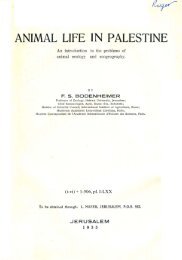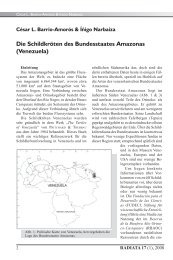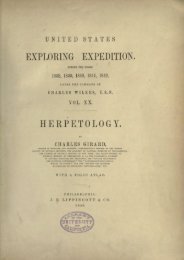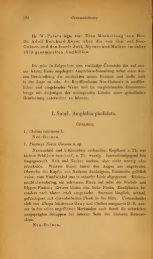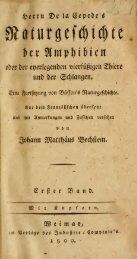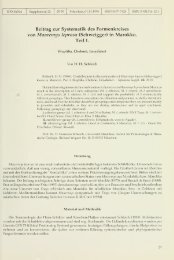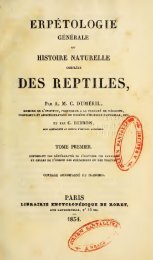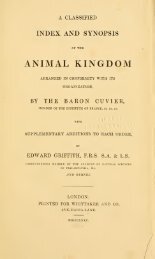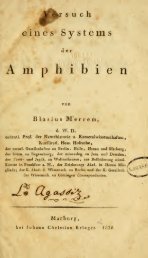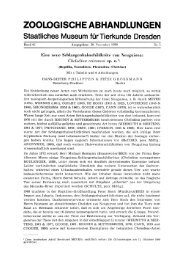Indian Peacock Softshell Turtle - IUCN Tortoise and Freshwater ...
Indian Peacock Softshell Turtle - IUCN Tortoise and Freshwater ...
Indian Peacock Softshell Turtle - IUCN Tortoise and Freshwater ...
You also want an ePaper? Increase the reach of your titles
YUMPU automatically turns print PDFs into web optimized ePapers that Google loves.
Conservation Biology of <strong>Freshwater</strong> <strong>Turtle</strong>s <strong>and</strong> <strong>Tortoise</strong>s:<br />
A Compilation Project of Trionychidae the <strong>IUCN</strong>/SSC <strong>Tortoise</strong> — Nilssonia <strong>and</strong> <strong>Freshwater</strong> hurum <strong>Turtle</strong> Specialist Group<br />
048.1<br />
A.G.J. Rhodin, P.C.H. Pritchard, P.P. van Dijk, R.A. Saumure, K.A. Buhlmann, J.B. Iverson, <strong>and</strong> R.A. Mittermeier, Eds.<br />
Chelonian Research Monographs (ISSN 1088-7105) No. 5, doi:10.3854/crm.5.048.hurum.v1.2010<br />
© 2010 by Chelonian Research Foundation • Published 14 December 2010<br />
Nilssonia hurum (Gray 1830) –<br />
<strong>Indian</strong> <strong>Peacock</strong> <strong>Softshell</strong> <strong>Turtle</strong><br />
In d r a n e I l da s 1 , dh r u va j y o t I Ba s u 2 , a n d sh a I l e n d r a sI n g h 3<br />
1 Institute of Biodiversity <strong>and</strong> Environmental Conservation, Universiti Malaysia Sarawak,<br />
94300 Kota Samarahan, Sarawak, Malaysia [idas@ibec.unimas.my];<br />
2 Katerniaghat Foundation, (R)1/737 Vikas Nagar, Lucknow 226 022, Uttar Pradesh, India [dhrubasu@rediffmail.com];<br />
3 Centre for Herpetology, Madras Crocodile Bank Trust, Post Bag 4, Mamallapuram 603 104,<br />
Tamil Nadu, India [shailendra_mcbt@yahoo.com]<br />
su m m a r y . – The <strong>Indian</strong> peacock softshell turtle, Nilssonia hurum (Family Trionychidae), is a<br />
relatively abundant large riverine species that is found in rivers <strong>and</strong> reservoirs. The species attains<br />
a rather large size (carapace length to 60 cm). It is distributed over eastern Pakistan, northern <strong>and</strong><br />
central India, Bangladesh, <strong>and</strong> Nepal. The species is primarily nocturnal <strong>and</strong> omnivorous, juveniles<br />
observed feeding on mosquito larvae <strong>and</strong> fish, while adults consume snails, earthworms, prawns,<br />
fish, frogs, carrion, <strong>and</strong> vegetation. Animals maintained in captivity are known to eat rice <strong>and</strong> palm<br />
sugar sweetmeats. Courtship takes place underwater, <strong>and</strong> spherical, brittle-shelled, eggs in clutches<br />
numbering 20–30 are produced between August to November; hatching takes place between June–<br />
July of the following year. The species is heavily exploited for its meat <strong>and</strong> calipee (the outer cartilaginous<br />
rim of the shell) throughout northern <strong>and</strong> eastern India <strong>and</strong> Bangladesh. The intensity of<br />
exploitation to which it is subject suggests that both some kind of quota or closed season system, as<br />
well as protection of nesting areas, are necessary.<br />
dI s t r I B u t I o n. – Bangladesh, India, Nepal, Pakistan. Distributed across eastern Pakistan, northern,<br />
central, <strong>and</strong> eastern India, southern Nepal, <strong>and</strong> all of Bangladesh.<br />
sy n o n y m y. – Trionyx occellatus Gray 1830a, Trionyx ocellatus, Gymnopus ocellatus, Trionyx<br />
hurum Gray 1830b, Isola hurum, Aspideretes hurum, Aspidonectes hurum, Tyrse hurum, Amyda<br />
hurum, Nilssonia hurum, Gymnopus duvaucelii Duméril <strong>and</strong> Bibron 1835, Trionyx sewaare Gray<br />
1872, Trionyx bellii Gray 1872, Trionyx buchanani Theobald 1874.<br />
su B s p e c I e s. – None.<br />
stat u s . – <strong>IUCN</strong> 2010 Red List: Vulnerable (A1cd+2d) (assessed 2000); CITES: Appendix I; <strong>Indian</strong><br />
Wildlife (Protection) Act: Schedule I; Bangladesh Wildlife (Preservation) Act: Schedule III.<br />
Taxonomy. — The first name proposed for this taxon<br />
was Trionyx occellatus Gray 1830a (Plate 78 in Illustrations<br />
of <strong>Indian</strong> Zoology; the specific epithet corrected later<br />
in the same work to Trionyx ocellatus), showing dorsal <strong>and</strong><br />
ventral views of a juvenile. Webb (1980) showed that Trionyx<br />
ocellatus Gray 1830 is a primary (junior) homonym<br />
Figure 1. Adult female Nilssonia hurum from the Brahmaputra River, India. Photo by Chittaranjan Baruah.
048.2 Conservation Biology of <strong>Freshwater</strong> <strong>Turtle</strong>s <strong>and</strong> <strong>Tortoise</strong>s • Chelonian Research Monographs, No. 5<br />
Figure 2. Adult Nilssonia hurum from Bangladesh. Photo by<br />
Indraneil Das.<br />
of Trionyx ocellatus LeSueur 1827, a synonym of Apalone<br />
spinifera (LeSueur 1827), <strong>and</strong> thus not available. Trionyx<br />
hurum Gray 1830b is the next available name, which was<br />
based on a manuscript name by the Scottish ichthyologist,<br />
Francis Hamilton (1762–1829), who later acquired the<br />
name Francis Buchanan (Theobald 1874), associated with<br />
Hamilton’s drawings in the British Museum, originating<br />
from “Indiae fluvio Ganges”, although the drawing bears<br />
the locality “Fatehgarh” (27º22’N, 79º38’E, Uttar Pradesh,<br />
northern India), to which the type locality was restricted by<br />
Smith (1931). Webb (1980) emended the type locality to<br />
“Barrackpore (about 23 km north of Calcutta), West Bengal,<br />
India” (= Barakpur, 22º45’N, 88º20’E). Webb (1980) <strong>and</strong><br />
Gemel <strong>and</strong> Praschag (2003) provided extensive discussions<br />
on the synonymy of Trionyx hurum, which includes Trionyx<br />
sewaare Gray 1872, Trionyx belli Gray 1872, <strong>and</strong> Trionyx<br />
buchanani Theobald 1874. The species was transferred to<br />
the genus Aspideretes by Meylan (1987), along with three<br />
other species of large trionychids that were formerly in the<br />
trionychid genus Trionyx. More recently, Praschag et al.<br />
(2007) argued for an exp<strong>and</strong>ed concept of Nilssonia, <strong>and</strong><br />
included the species of Aspideretes in it.<br />
Figure 4. Juvenile Nilssonia hurum from Assam, India. Photo by<br />
Indraneil Das.<br />
Figure 3. Adult Nilssonia hurum from India. Photo by Shailendra<br />
Singh.<br />
Description. — The carapace is low <strong>and</strong> oval <strong>and</strong> the<br />
anterior edge has blunt tubercles. The head is large, <strong>and</strong> the<br />
snout is strongly downturned. A straight carapace length<br />
(bony disk plus leathery cartilaginous flap) of 60 cm is attained<br />
(Ann<strong>and</strong>ale 1912a).<br />
The carapace is dark olive green to nearly black,<br />
sometimes with a yellow rim, <strong>and</strong> juveniles have 4 striking,<br />
orange ringed dark-centered ocelli, that are subequal <strong>and</strong><br />
symmetrically positioned on an olive green carapace with<br />
dark reticulation; the eye-like markings becoming obscured<br />
with growth when the shell becomes darker. The plastron is<br />
dark in juveniles, turning light gray in adults. The head <strong>and</strong><br />
limbs are olive green; the forehead has dark reticulations <strong>and</strong><br />
large yellow or orange patches or spots, especially behind<br />
the eyes <strong>and</strong> across the snout, that are larger than those in its<br />
sister species, N. nigricans. These head markings are evident<br />
even in large individuals in which the carapacial pattern has<br />
been lost.<br />
Males possess relatively longer <strong>and</strong> thicker tails than<br />
females, with the cloaca situated close to the tail-tip. No<br />
sexual dimorphism in shell color or patterns or size have<br />
been reported.<br />
Figure 5. Juvenile Nilssonia hurum from Assam, India. Photo by<br />
Indraneil Das.
Trionychidae — Nilssonia hurum 048.3<br />
Figure 6. Distribution of Nilssonia hurum in Pakistan, India, <strong>and</strong> Bangladesh. Red points = museum <strong>and</strong> literature occurrence records<br />
based on Iverson (1992) plus more recent <strong>and</strong> authors’ data; green shading = projected distribution based on GIS-defined hydrologic<br />
unit compartments (HUCs) constructed around verified localities <strong>and</strong> then adding HUCs that connect known point localities in the same<br />
watershed or physiographic region, <strong>and</strong> similar habitats <strong>and</strong> elevations as verified HUCs (Buhlmann et al. 2009), <strong>and</strong> adjusted based on<br />
authors’ data. The question mark indicates the isolated questionable locality of Pune, Maharashtra.<br />
The bony carapacial disk has eight pairs of costals <strong>and</strong><br />
two (or sometimes three) neurals between the first pair of<br />
costals. The skull has ridgeless maxillary triturating surfaces<br />
with a median groove.<br />
No subspecies have been described, although Rashid<br />
<strong>and</strong> Swingl<strong>and</strong> (1997) suggested that the northern population<br />
differed from the southern one in color <strong>and</strong> snout shape.<br />
The karyotype is unknown. Genetic work on the species<br />
has been conducted by Praschag et al. (2007), that allocate it<br />
to Nilssonia, <strong>and</strong> reveal a sister relationship with N. nigricans.<br />
Earlier, Engstrom et al. (2004) conduced a wider phylogeographic<br />
analysis of all extant species of Trionychidae, <strong>and</strong><br />
revealed a relationship with the three South Asian species<br />
of large, softshell turtles (Nilssonia gangetica, N. nigricans,<br />
N. leithii), plus the Myanmar endemic (N. formosa), which<br />
they retained in the clade Aspideretini Hay (1903).<br />
Distribution. — The <strong>Indian</strong> peacock softshell turtle is<br />
widespread in the northern <strong>and</strong> central parts of the <strong>Indian</strong><br />
subcontinent, but the southern <strong>and</strong> eastern limits of its distribution<br />
remain unclear. Verified examples have come from<br />
the tributaries of the rivers Indus, Ganga, Brahmaputra, <strong>and</strong><br />
Subarnarekha, as well as their numerous tributaries (Smith<br />
1931; Moll <strong>and</strong> Vijaya 1986), as well as from isolated bodies<br />
of water, sometimes far from major river drainages, for<br />
example: Puri, Orissa (Ann<strong>and</strong>ale 1912b); Pune, Maharashtra<br />
(Varghese <strong>and</strong> Tonapi 1986); Bhopal, Madhya Pradesh (Das<br />
1987); Bharatpur, Rajasthan (Bhupathy <strong>and</strong> Ajith Kumar<br />
1988); Misrik, Uttar Pradesh (Pai <strong>and</strong> Basu 1988); <strong>and</strong><br />
Jiribam, Manipur (Singh 1995).<br />
The record from Dohazari, south of Chittagong, in<br />
extreme southeastern Bangladesh (Das 1989), is of inter-<br />
est, <strong>and</strong> suggests that N. hurum might conceivably occur in<br />
western Myanmar as well, although that remains unverified,<br />
<strong>and</strong> the international border east of Chittagong corresponds<br />
to a mountain range that separates river systems in the two<br />
countries. Mertens (1969) reported a specimen from Pakistan,<br />
<strong>and</strong> this species has since been confirmed from the Indus<br />
drainage by Khan (2006), Noureen (2007), Noureen <strong>and</strong><br />
Khan (2007, 2008), <strong>and</strong> Noureen et al. (2008). The records<br />
from Nepal are from the western, central, <strong>and</strong> Terai regions<br />
(Mitchell <strong>and</strong> Rhodin 1996; Schleich <strong>and</strong> Kästle 2002).<br />
Old records of the species from Indo-China (Mocquard<br />
1907), the Malay Peninsula (Flower 1899), <strong>and</strong> Borneo (de<br />
Rooij 1917), are based on erroneous identifications (see<br />
Ann<strong>and</strong>ale 1912a).<br />
Habitat <strong>and</strong> Ecology. — The <strong>Indian</strong> peacock softshell<br />
turtle utilizes rivers, lakes, <strong>and</strong> ponds, from the upper reaches<br />
of the rivers, to the lowest, while apparently avoiding the<br />
saline river mouths. Its ability to burrow into the mud, while<br />
not as developed as that of Lissemys, may be associated<br />
with its ability to inhabit ponds <strong>and</strong> other lentic environments<br />
that may dry up during the dry season. Individuals<br />
were observed to surface every after 20–30 min in the<br />
Sarju River in the summer, comparatively more frequent<br />
than other sympatric softshelled turtle species such as N.<br />
gangetica or L. punctata. Adults were observed to utilize<br />
deeper sections of the river, while yearlings appears to<br />
stay in the shallower parts. Rashid <strong>and</strong> Swingl<strong>and</strong> (1997)<br />
mentioned that the species migrates from drying ponds,<br />
<strong>and</strong> that is known to bask on the surface of water. The<br />
low abundance of this species in rivers like the Chambal<br />
in the western parts of its distribution may be due to the
048.4 Conservation Biology of <strong>Freshwater</strong> <strong>Turtle</strong>s <strong>and</strong> <strong>Tortoise</strong>s • Chelonian Research Monographs, No. 5<br />
increasing gravelly nature of river beds, in comparison to<br />
the clayey beds of rivers in the eastern regions.<br />
The species is reportedly primarily nocturnal (Noureen<br />
<strong>and</strong> Baruah 2010) <strong>and</strong> omnivorous; juveniles have been<br />
observed feeding on mosquito larvae <strong>and</strong> fish in captivity,<br />
<strong>and</strong> the stomach of a wild-collected adult in northern India<br />
contained fragments of snail shells (Das 1991). In Bangladesh,<br />
stomach samples contained earthworms (Pheretima<br />
posthuma), molluscs (Pila globosa), prawns, fish (including<br />
Amblypharyngodon mola, Mystus tengra, <strong>and</strong> N<strong>and</strong>us<br />
n<strong>and</strong>us), frogs, as well as carrion <strong>and</strong> vegetable matter<br />
(Rashid <strong>and</strong> Swingl<strong>and</strong> 1997; Schleich <strong>and</strong> Kaästle 2002).<br />
Khan (1987) reported the species to be omnivorous. Animals<br />
maintained at a temple tank in Puri, Orissa, eastern India,<br />
took rice <strong>and</strong> sweetmeats made of palm sugar (Ann<strong>and</strong>ale<br />
1912b). Individuals maintained in the temple tanks <strong>and</strong> village<br />
ponds in Uttar Pradesh <strong>and</strong> Assam, India, were seen to<br />
feed on puffed rice, bread, <strong>and</strong> material generated as garbage<br />
as a result of religious activities (S. Singh, pers. obs.).<br />
Flower’s (1899) description of courtship in the species,<br />
reportedly underwater, with the males biting the females, <strong>and</strong><br />
vocalizing, may refer to Amyda cartilaginea or an unknown<br />
turtle species, as Nilssonia hurum does not occur in southeast<br />
Asia.<br />
In Bangladesh, nests are 10–30 m away from the edge<br />
of water, <strong>and</strong> 15–25 cm deep; the spherical, ca. 30 mm in<br />
diameter, brittle-shelled eggs, numbering 20–30 eggs in a<br />
clutch are produced during the winter months, <strong>and</strong> there is<br />
evidence of multiple clutching in Bangladesh (Rashid <strong>and</strong><br />
Swingl<strong>and</strong> 1997). Nesting of N. hurum in the Chambal occurs<br />
along with that of N. gangetica in the months of August<br />
to November, <strong>and</strong> hatching takes place in June–July of the<br />
following year. Clutch range in the Chambal is 10–30, with<br />
a mean of 18 (D. Basu, pers. obs.). Hatchling takes place<br />
just before the main monsoons (mid-June to mid-July) on<br />
the Sarju River, in the north <strong>Indian</strong> Terai (foothills of the<br />
Himalayas). One recently hatched nest was examined from<br />
a dried-up nulllah (stream) adjacent to the Sarju River. The<br />
mean carapace length of three hatchlings was 46 mm.<br />
The trematode parasite, Cephalogonimus mukerjius is<br />
known to infect this turtle (Rai 1961).<br />
Population Status. — No information on population<br />
sizes is available. This appears to be the most common large<br />
softshell turtle in the lower parts of the Ganges system;<br />
however, in the central <strong>and</strong> upper regions the species appears<br />
to be outnumbered by N. gangetica. In the Chambal<br />
River, N. hurum nests comprised < 2% of N. gangetica nests<br />
(D. Basu, unpubl. data). The species was fairly abundant in<br />
slow-flowing rivers <strong>and</strong> wetl<strong>and</strong>s in the Terai of northern<br />
India, but populations seem to be declining due to commercial<br />
exploitation <strong>and</strong> habitat alteration. The notable north <strong>Indian</strong><br />
habitats, where large populations of the species have recently<br />
been recorded, are Sarju, Kane, <strong>and</strong> Rapti rivers, <strong>and</strong> a few<br />
oxbow lakes in the area (S. Singh, pers. obs.). In Azam <strong>and</strong><br />
R<strong>and</strong>hawa’s (2008) study site in Pakistan’s Punjab Province<br />
(at Head Punjnad <strong>and</strong> Head Trimmu), N. hurum was the<br />
most abundant turtle species (after Pangshura smithii), <strong>and</strong><br />
was described as “plentiful” in “shallow muddy ditches,<br />
lakes <strong>and</strong> marshes”. In another study in the same province<br />
of Pakistan, Akbar et al. (2006) described the species as<br />
frequently encountered. In Bangladesh, this appears to be the<br />
most abundant large softshell turtle (Rashid <strong>and</strong> Swingl<strong>and</strong><br />
1997), although the concept of N. hurum at the time also<br />
included the often sympatric <strong>and</strong> morphologically similar<br />
N. nigricans.<br />
Threats to Survival. — Ann<strong>and</strong>ale (1912a) reported<br />
a consignment of over 500 individuals from Khulna, currently<br />
in Bangladesh, in the early 1900s, mentioning that<br />
the trade was restricted to the month of October. Based on<br />
market surveys conducted in the early 1980s, Moll (1983)<br />
found the species to be the third most commonly exploited<br />
turtle in eastern India, after L. punctata <strong>and</strong> N. gangetica.<br />
Threats in the River Ganga to the species are those generic<br />
for all large river turtles, including reduction of fish stock,<br />
as a result of overfishing, pollution, increase in river traffic,<br />
<strong>and</strong> s<strong>and</strong>-mining, among others (Rao 2001).<br />
The species is extensively hunted in all of northern <strong>and</strong><br />
eastern India for its meat <strong>and</strong> calipee (the outer cartilaginous<br />
rim of the shell), which is extracted from live turtles<br />
by removing up to ca. 10 cm of the rim from limb to limb.<br />
The calipee is dried <strong>and</strong> sold along with that of sympatric<br />
species such as N. gangetica <strong>and</strong> Chitra indica. The calipee<br />
comm<strong>and</strong>s a higher price (due to low fat content) in comparison<br />
to that of the <strong>Indian</strong> narrow-headed softshell, Chitra<br />
indica, <strong>and</strong> one kilo of dried calipee fetching fishermen 1700<br />
<strong>Indian</strong> Rupees (ca. US$ 22) from middlemen. It is probable<br />
that the final destinations are the markets of China <strong>and</strong>/or<br />
Southeast Asia, via Bangladesh, where it is used in cuisine<br />
<strong>and</strong> Traditional Chinese Medicine (TCM). A single animal of<br />
30 kg can produce about 650 g of dried calipee. In the state<br />
of Uttar Pradesh, turtlers typically locate the species using<br />
an iron probe during the dry season, baited <strong>and</strong> unbaited<br />
“thous<strong>and</strong> hook” lines before <strong>and</strong> after the monsoons, <strong>and</strong><br />
fall <strong>and</strong> set nylon nets during the winter. In the state of Uttar<br />
Pradesh, the species was recorded in five of 11 live <strong>and</strong><br />
dead consignments (comprising over 500 turtles of different<br />
species) seized by the Uttar Pradesh Police Department in<br />
2009. Noureen <strong>and</strong> Baruah (2010) reported that in the first<br />
week of November, large numbers of eggs of this species<br />
are excavated from isl<strong>and</strong>s on the Brahmaputra, for local<br />
consumption or sale.<br />
In Bangladesh, N. hurum is the most heavily exploited<br />
species, most animals caught ending up in markets in Southeast<br />
Asia (Das 1990; Rashid <strong>and</strong> Swingl<strong>and</strong> 1990). Export<br />
peaked between the mid-1980s <strong>and</strong> early 1990s, when ca.<br />
10,000 metric tonnes of the species were exported annually<br />
(Rashid <strong>and</strong> Khan 2000). Fugler (1984) noted that in Bangladesh,<br />
these turtles are caught with hooks fixed to short<br />
cords, which are attached at intervals of about half a meter<br />
to a 60–600 m cord, <strong>and</strong> baited with offal, mussel, shrimp<br />
or fish.<br />
In Pakistan, the species is exploited for export to China,<br />
both as meat <strong>and</strong> calipee (Noureen <strong>and</strong> Khan 2007, 2008;<br />
Noureen et al., 2008); other local threats being incidental
capture in fishing gear, canal closure, <strong>and</strong> desiltation of water<br />
bodies (Akbar et al. 2006). Trade reports for China (Zhang et<br />
al. 2008) confirm the importation of this turtle for use in the<br />
food <strong>and</strong> indigenous medicine trade. In Nepal, the species<br />
is reportedly used for food <strong>and</strong> medicine (Shah <strong>and</strong> Tiwari<br />
2004).<br />
Conservation Measures Taken. — The species is<br />
listed under Appendix I of CITES, Schedule I of the <strong>Indian</strong><br />
Wildlife (Protection) Act 1972, Appendix III of the Wildlife<br />
Protection Ordinance for Sindh, Punjab, Balochistan, <strong>and</strong><br />
Northwest Frontier Agency (all in Pakistan), <strong>and</strong> Schedule<br />
III of the Bangladesh Wildlife (Preservation) Act of 1974.<br />
Its export from Pakistan has been banned by the Pakistan<br />
Export Policy, 2006–2007. Nonetheless, continuing illegal<br />
export to China for TCM, especially from Bangladesh <strong>and</strong><br />
Pakistan, appears to occur frequently (Rashid <strong>and</strong> Khan<br />
2000; Noureen <strong>and</strong> Khan 2007, 2008; Noureen et al. 2008).<br />
The species is included in the Red Data Book for Nepal<br />
(Shah <strong>and</strong> Tiwari 2004). The <strong>IUCN</strong> Red List categorizes<br />
the species as Vulnerable (www.iucnredlist.org).<br />
This species occurs in several protected areas within its<br />
natural range, including the Pakhui Wildlife Sanctuary (Arunachal<br />
Pradesh), Mupa-Lanteng Reserve Forest (Assam),<br />
Bherihari Wildlife Sanctuary (Bihar), Hastinapur Wildlife<br />
Sanctuary (Uttar Pradesh), Sarnath <strong>Turtle</strong> Sanctuary (Uttar<br />
Pradesh), the National Chambal Sanctuary (Madhya Pradesh<br />
<strong>and</strong> Rajasthan), <strong>and</strong> Keoladeo National Park (Rajasthan) in<br />
India <strong>and</strong> the Sunderban Wildlife Sanctuaries (comprising<br />
East, West <strong>and</strong> South sectors) of Bangladesh. Some efforts<br />
to restore the heavily polluted River Ganga via pollution<br />
control have begun in the past decade (Rao 2001).<br />
Conservation Measures Proposed. — Trade in the<br />
species may be difficult to stop in the short-term, <strong>and</strong> the<br />
protection of nesting grounds, especially during the breeding<br />
season, <strong>and</strong> other critical habitats of the species, in addition to<br />
better enforcement, especially addressing transborder trade,<br />
may be a more suitable strategy. Thus, better enforcement<br />
<strong>and</strong> partial amendments of the existing laws may be warranted,<br />
to allow some sustainable utilization of this large,<br />
commercially valuable species. These include annual quotas<br />
on numbers removed or a closed season system, as well as<br />
protection of nesting areas. The turtle hunters may need<br />
to be rehabilitated through encouragement to opt for more<br />
river-friendly livelihoods, rather than catching turtles for<br />
middlemen for nominal monetary gains<br />
Captive Husb<strong>and</strong>ry. —Ann<strong>and</strong>ale (1912b) reported<br />
a population of this species in captivity at a temple in Puri,<br />
Orissa State, eastern India, but P.C.H. Pritchard reported in<br />
the 1980s (pers. comm.) that this captive colony appears to<br />
have died out. Juveniles maintained in captivity ate fishes<br />
<strong>and</strong> mosquito larvae (I. Das, pers. obs.). Varghese <strong>and</strong> Tonapi<br />
(1986) classified the species as carnivorous, reporting annelids,<br />
molluscs, arthropods, fish fingerlings, <strong>and</strong> tadpoles<br />
in its diet in captivity. These authors also reported that while<br />
macrophytes are generally avoided, floating root-tips of<br />
plants are ingested when starved for 1–2 weeks. Animals<br />
kept in temple ponds in eastern India feed on offerings from<br />
Trionychidae — Nilssonia hurum 048.5<br />
pilgrims, including cakes, fruits, animal viscera <strong>and</strong> rice<br />
(Noureen <strong>and</strong> Baruah 2010). Such animals are vulnerable<br />
to both inbreeding, aggression as a result of high stocking<br />
densities, <strong>and</strong> fungal attack. One large die-off in August<br />
2008, involving about 13 turtles at the Madhab Temple at<br />
Hajo, Assam, in eastern India was reported by Noureen <strong>and</strong><br />
Baruah (2010).<br />
Current Research. — The reproductive biology <strong>and</strong><br />
scale of trade of the species is being studied by Shailendra<br />
Singh, supported by the <strong>Turtle</strong> Survival Alliance, in northern<br />
India.<br />
Acknowledgments. — Supported by the Centre for<br />
Herpetology, Madras Crocodile Bank Trust, Universiti Malaysia<br />
Sarawak, <strong>and</strong> the Katerniaghat Foundation. The <strong>Turtle</strong><br />
Survival Alliance is thanked for the current species initiative.<br />
John Iverson offered helpful comments on a draft. We thank<br />
Chittaranjan Baruah for contributing the photo in Fig. 1.<br />
LITERATURE CITED<br />
Ak b a r, M., Mu s h ta q-u l-Ha s s a n, M. a n d Za i b-u-Nisa. 2006. Distribution<br />
of freshwater turtles in Punjab, Pakistan. Caspian Journal<br />
of Environmental Sciences 4:142–146.<br />
An n a n d a l e, N. 1912a. The <strong>Indian</strong> mud-turtles (Trionychidae).<br />
Records of the <strong>Indian</strong> Museum 7:151–179.<br />
An n a n d a l e, N. 1912b. The aquatic Chelonia of the Mahanaddi <strong>and</strong><br />
its tributaries. Records of the <strong>Indian</strong> Museum 7:261–266.<br />
Az a m, M.M. a n d Ra n d h awa, A.A. 2008. Studies on Wildlife Diversity<br />
of Two Wetl<strong>and</strong>s With Particular Reference to <strong>Freshwater</strong> <strong>Turtle</strong>s.<br />
Islamabad: Zoological Survey Department, 20 pp.<br />
Bu h l m a n n, K.A., Ak r e, T.S.B., Iv e r s o n, J.B., Ka r a pata k i s, D., Mittermeier,<br />
R.A., Ge o r g e s, A., Rh o d i n, A.G.J., va n Dijk, P.P., a n d<br />
Gi b b o n s, J.W. 2009. A global analysis of tortoise <strong>and</strong> freshwater<br />
turtle distributions with identification of priority conservation areas.<br />
Chelonian Conservation <strong>and</strong> Biology 8(2):116–149.<br />
Bh u pat h y, S. <strong>and</strong> Ajith Ku m a r, C.R. 1988. On the identity <strong>and</strong> occurrence<br />
of the peacock soft shell (Trionyx hurum) in Rajasthan.<br />
Journal of the Bombay Natural History Society 85:624.<br />
Da s, I. 1987. New locality record for the <strong>Indian</strong> peacock softshell<br />
turtle Trionyx hurum. Journal of the Bombay Natural History<br />
Society 84:691–692.<br />
Da s. 1989. Report of a survey of freshwater turtles <strong>and</strong> l<strong>and</strong> tortoises<br />
in Bangladesh. Report to the Fauna <strong>and</strong> Flora Preservation Society,<br />
London, 10 pp.<br />
Da s, I. 1990. The trade in freshwater turtles from Bangladesh. Oryx<br />
24:163–166.<br />
Da s, I. 1991. Colour Guide to the <strong>Turtle</strong>s <strong>and</strong> <strong>Tortoise</strong>s of the <strong>Indian</strong><br />
Subcontinent. Portishead: R & A Publishing, 133 pp.<br />
d e Ro o i j, N. 1915. The Reptiles of the Indo-Australian Archipelago. Vol.<br />
I. Lacertilia, Chelonia, Emydosauria. Leiden: E.J. Brill, 384 pp.<br />
En g s t r o m, T.N., Sh a f f e r, H.B., a n d McCo r d, W.P. 2004. Multiple<br />
data sets, high homoplasy, <strong>and</strong> the phylogeny of softshell turtles<br />
(Testudines: Trionychidae). Systematic Biology 53:693–710.<br />
Flower, S.S. 1899. Notes on a second collection of reptiles made in<br />
the Malay Peninsula <strong>and</strong> Siam, from November 1896 to September<br />
1898, with a list of species recorded in these countries. Proceedings<br />
of the Zoological Society of London 1899:600–696.<br />
Fu g l e r, C.M. 1984. The commercially exploited Chelonia of Bangladesh:<br />
taxonomy, ecology, reproductive biology, <strong>and</strong> ontogeny.<br />
Bangladesh Fisheries Information Bulletin 2(1):1–52.
048.6 Conservation Biology of <strong>Freshwater</strong> <strong>Turtle</strong>s <strong>and</strong> <strong>Tortoise</strong>s • Chelonian Research Monographs, No. 5<br />
Gemel, R. a n d Pr a s c h a g, P. 2003. On the nomenclature <strong>and</strong> vernacular<br />
names of recent Aspideretes species (Reptilia, Testudines, Trionychidae).<br />
Zoologische Abh<strong>and</strong>lungen, Dresden 53:93–105.<br />
gr ay , J.E. 1830a. Illustrations of <strong>Indian</strong> Zoology, chiefly selected<br />
from the collection of Major-General Hardwicke. Vol. I, Part 4,<br />
pls. 75, 78. London: Treuttel, Wurtz, Treuttel, Jun. <strong>and</strong> Richter.<br />
gr ay , J.E. 1830b. A Synopsis of the Species of the Class Reptilia.<br />
In: Griffith E. <strong>and</strong> Pidgeon, E. The Class Reptilia arranged by the<br />
Baron Cuvier, with specific descriptions. In: Griffith, E. (Ed.). The<br />
Animal Kingdom Arranged in Conformity with its Organization, by<br />
the Baron Cuvier, with Additional Descriptions of all the Species<br />
Hitherto Named, <strong>and</strong> of many not before Noticed. Vol. 9. Reptilia.<br />
Supplement. London: Whittaker, Treacher, <strong>and</strong> Co., 110 pp.<br />
Gr ay , J.E. 1872. Notes on the mud-tortoises of India (Trionyx, Geoffroy).<br />
Annals <strong>and</strong> Magazine of Natural History (4)10:326–340.<br />
Hay , O.P. 1903. On the existing genera of the Trionychidae. Proceedings<br />
of the American Philosophical Society 42:268–274.<br />
Iv e r s o n, J.B. 1992. A Revised Checklist with Distribution Maps<br />
of the <strong>Turtle</strong>s of the World. Richmond, IN: Privately published,<br />
363 pp.<br />
Kh a n, M.A.R. 1987. Bangladesher Bonnyoprani. Vol. I. Urochor o<br />
Shorishrip. Dhaka: Bangla Academy, 169 pp.<br />
Kh a n, M.S. 2006. Amphibians <strong>and</strong> Reptiles of Pakistan. Malabar,<br />
FL: Krieger Publishing Company, 311 pp.<br />
Lesu e u r, C.A. 1827. Notes sur deux espèces de tortues du genre<br />
Trionyx Geoffroy-Saint Hillaire. Mémoirs du Muséum d’Histoire<br />
Naturelle de Paris 15:257–268.<br />
Mertens, R. 1969. Die Amphibien und Reptilien West-Pakistans.<br />
Stuttgarter Beiträge zur Naturkunde 197:1–96.<br />
Me y l a n, P.A. 1987. The phylogenetic relationships of soft-shelled<br />
turtles (Family Trionychidae). Bulletin of the American Museum<br />
of Natural History 186:1–101.<br />
Mitchell, J.C. a n d Rh o d i n, A.G.J. 1996. Observations on the<br />
natural history <strong>and</strong> exploitation of the turtles of Nepal, with life<br />
history notes on Melanochelys trijuga. Chelonian Conservation<br />
<strong>and</strong> Biology 2:66–72.<br />
Mo c q u a r d, F. 1907. Les reptiles de l’Indochine. La Revue Coloniale,<br />
Paris 1907:5–59.<br />
Mo l l, E.O. 1983. A status survey of freshwater turtle resources in<br />
India (September 1982 – June 1983) with recommendations for<br />
management. New Delhi: Report to the American Institute for<br />
<strong>Indian</strong> Studies, 26 pp.<br />
No u r e e n, U. 2007. A preliminary visit to Dera Ismail Khan to assess<br />
the status of freshwater turtles of Pakistan. Report to the Ministry<br />
of Environment, Pakistan Wetl<strong>and</strong>s Programme, 23 pp.<br />
No u r e e n, U. a n d Ba r u a h, C. 2010. Le Trionyx à ocelles Nilssonia<br />
hurum (Gray, 1831) (Ang: <strong>Indian</strong> peacock softshell turtle). Chéloniens<br />
18:39–45.<br />
No u r e e n, U. a n d Kh a n, A. 2007. <strong>Freshwater</strong> turtles of Pakistan: a<br />
preliminary assessment of their status in Punjab <strong>and</strong> Sindh. Report<br />
to the Ministry of Environment’s Pakistan Wetl<strong>and</strong>s Programme,<br />
Islamabad, 23 pp.<br />
no u r e e n, u. a n d kh a n, A. 2008. Conservation of freshwater turtles<br />
in Pakistan. TRAFFIC Bulletin 21(3):99–100.<br />
no u r e e n, u., br a u l i k, t.g., ar s h a d, m., a n d kh a n, h.n. 2008. Illegal<br />
trade in freshwater turtle parts: preliminary findings of turtle trade<br />
in major barrages <strong>and</strong> head-works of Punjab. Report to the Ministry<br />
of Environment’s Pakistan Wetl<strong>and</strong>s Programme, 28 pp.<br />
Pa i, A. a n d Ba s u, D. 1988. <strong>Turtle</strong>s of an ancient pilgrimage tank in<br />
north India with notes on the distribution of the peacock soft-shell<br />
turtle (Trionyx hurum). Hamadryad 13:12–15.<br />
Pr a s c h a g, P. a n d Gemel, R. 2002. Identity of the black soft-shell<br />
turtle Aspideretes nigricans (Anderson, 1875), with remarks on<br />
related species (Reptilia: Testudines: Trionychidae). Faunistische<br />
Abh<strong>and</strong>lungen Staatliches Museum für Tierkunde Dresden<br />
23(5):87–116.<br />
Pr a s c h a g, P., Hu n d s d ö r f e r, A.K., Reza, A.H.M.A, a n d Fr i t z, U.<br />
2007. Genetic evidence for wild-living Aspideretes nigricans<br />
<strong>and</strong> a molecular phylogeny of south Asian softshell turtles (Reptilia:<br />
Trionychidae: Aspideretes, Nilssonia). Zoologica Scripta<br />
36:301–310.<br />
Ra i, S.L. 1961. On a new trematode Cephalogonimus mukerjius n.<br />
sp. of the genus Cephalogonimus Poirier, 1886, from the intestine<br />
of Trionyx hurum. <strong>Indian</strong> Journal of Helminthology 13:79–92.<br />
Ra o, R.J. 2001. Biological resources of the Ganga River, India.<br />
Hydrobiologia 458:159–168.<br />
Ra s h i d, S.M.A. a n d Kh a n, S.M.H. 2000. Overview of turtle trade in<br />
Cambodia. In: van Dijk, P.P., Stuart, B.L., <strong>and</strong> Rhodin, A.G.J. (Eds.).<br />
Asian <strong>Turtle</strong> Trade: Proceedings of a Workshop on Conservation<br />
<strong>and</strong> Trade in <strong>Freshwater</strong> <strong>Turtle</strong>s <strong>and</strong> <strong>Tortoise</strong>s in Asia. Chelonian<br />
Conservation Monographs 2:77–85.<br />
Ra s h i d, S.M.A. a n d Sw i n g l a n d, I.R. 1990. Interim report on the<br />
freshwater turtle trade in Bangladesh. Asiatic Herpetological<br />
Research 3:123–128.<br />
Ra s h i d, S.M.A. a n d Sw i n g l a n d, I.R. 1997. On the ecology of some<br />
freshwater turtles in Bangladesh. In: Van Abbema, J. (Ed.). Proceedings:<br />
Conservation, Restoration, <strong>and</strong> Management of <strong>Tortoise</strong>s<br />
<strong>and</strong> <strong>Turtle</strong>s – An International Conference. New York: New York<br />
<strong>Turtle</strong> <strong>and</strong> <strong>Tortoise</strong> Society, pp. 225–242.<br />
Sh a h, K.B. a n d Ti w a r i, S. 2004. Herpetofauna of Nepal. A Conservation<br />
Companion. Kathm<strong>and</strong>u: <strong>IUCN</strong> Nepal, 237 pp.<br />
Sc h l e i c h, H.H. a n d Kästle, W. 2002. Order Chelonia/Testudines<br />
(turtles: terrapins <strong>and</strong> tortoises). In: Schleich, H.H. <strong>and</strong> Kästle, W.<br />
(Eds.). Amphibians <strong>and</strong> Reptiles of Nepal. Biology, Systematics,<br />
Field Guide. Königstein: Koeltz Scientific Books, pp. 501–573.<br />
Si n g h, K. S. 1995. On a collection of reptiles <strong>and</strong> amphibians of<br />
Manipur. Geobios News Reports 14:135–145.<br />
Th e o b a l d, W. 1874. Observations on some <strong>Indian</strong> <strong>and</strong> Burmese<br />
species of Trionyx. Proceedings of the Asiatic Society of Bengal<br />
1874:75–87.<br />
Va r g h e s e, G. a n d To n a p i, G.T. 1986. Observations on the identity of<br />
some <strong>Indian</strong> freshwater turtles <strong>and</strong> their feeding habits. Biological<br />
Conservation 37:87–92.<br />
We b b, R.G. 1980. Gray, Hardwicke, Buchanan-Hamilton, <strong>and</strong> drawings<br />
of <strong>Indian</strong> softshell turtles (Family Trionychidae). Amphibia-<br />
Reptilia 1:61–74.<br />
Zh a n g, L., Hu a N., a n d Su n, S. 2008. Wildlife trade, consumption<br />
<strong>and</strong> conservation awareness in southwest China. Biodiversity <strong>and</strong><br />
Conservation 17:1493–1516.<br />
Citation Format for this Account:<br />
da s, i., ba s u, d., a n d si n g h, s. 2010. Nilssonia hurum (Gray<br />
1830) – <strong>Indian</strong> peacock softshell turtle. In: Rhodin, A.G.J.,<br />
Pritchard, P.C.H., van Dijk, P.P., Saumure, R.A., Buhlmann,<br />
K.A., Iverson, J.B., <strong>and</strong> Mittermeier, R.A. (Eds.). Conservation<br />
Biology of <strong>Freshwater</strong> <strong>Turtle</strong>s <strong>and</strong> <strong>Tortoise</strong>s: A Compilation<br />
Project of the <strong>IUCN</strong>/SSC <strong>Tortoise</strong> <strong>and</strong> <strong>Freshwater</strong> <strong>Turtle</strong><br />
Specialist Group. Chelonian Research Monographs No. 5, pp.<br />
048.1–048.6, doi:10.3854/crm.5.048.hurum.v1.2010, http://<br />
www.iucn-tftsg.org/cbftt/.



